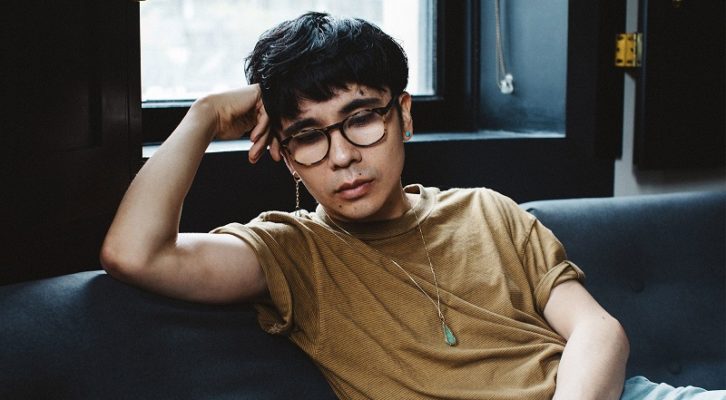
Ocean Vuong: The 10 Books
I Needed to Write My Novel
On Herman Melville, Theresa Hak Kyung Cha, James Baldwin, lê thị diễm thúy, and More
As a culture, we often fetishize the debut writer as some sort of self-arising wunderkind, someone that comes “out of nowhere” or had “splashed onto the scene” unannounced, seemingly without a pre-history or predecessors. This is compounded for writers of color, who seem, according to this narrative, to arrive at the literary table by “transcending” their cultural, economic or racial milieu into the hegemonic literati. I want to take a moment, in light of this, to put some shine on 10 books that made my debut, On Earth We’re Briefly Gorgeous, possible.
Some of these texts (in no particular order) are canonical, some are not—but they each had an idiosyncratic force on my education as a writer and informed and enriched On Earth We’re Briefly Gorgeous, and in particular, supported the novel’s metaphor-rich approach. The metaphor, heavily used in the 19th century as a means toward the ecstatic sublime, became more passé after the World Wars, when the pastoral dream was no longer feasible amidst European fields rotting with cattle corpses. I wanted to use the metaphor differently, on terms removed from a Eurocentric worldview.
Vietnamese refugees, for example, use metaphor as a coping mechanism; metaphor provides a way to talk about trauma without stating the experience outright. An abortion is described as having “papaya seeds scraped out of you,” or sexual assault as having “the doorway of your body broken into.” To die is to”“get on the road.” Likewise, when Abel Meeropol wrote the poem “Strange Fruit” about the lynching of African Americans in the South, he was not reaching for the Romantic sublime—but to render the horrific via an alternative speech act. The metaphor in the mouths of survivors became a way to innovate around pain.
These texts also helped in formulating the novel’s shape. Using Kishōtenketsu, a narrative structure used in Chinese poetry, then later developed in Japanese storytelling, I was able to write about American violence without it becoming vital to the novel’s arc. It was important to me, at least in this book, that violence remain independent from any character’s self-worth, rendering it inert, terrible, and felt—but not a means of “development.” Through Kishōtenketsu, violence becomes fact and not a vehicle towards a climax. Having been a student mainly of Western literature, it became clear to me that the most perennial protagonist is not necessarily the main character, but conflict-driven plot. In Western narratology, the plot is the dominant mode to which all characters are subordinate. But I wanted a novel to hold these characters thoroughly and, most importantly, on their own terms, free from a system of governance, even one of my own making. I could not employ the plot-heavy strategy because I needed these people to exist as they are, full of stories but not for a story.
The truth is no writer comes “out of nowhere” and wunderkinds are only as real as our aversion to a more sobering—albeit less glamorous—reality: that a writer’s growth is often a slog, the slow burn of reading and trying and failing when, finally, by some luck or mercy, the book you’re reading turns into a torch in your hands. And with it you make a sentence so new and exacting to your desire that it startles you into a new vision, a new life, one that exists through the presence of elders before you, both here and gone and some nearly forgotten but never lost.
These authors and their books found me. They helped realize my thinking. Hopefully they will do the same, however large or small, for you.
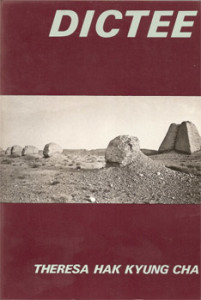
Theresa Hak Kyung Cha, Dictee
This book is one of the most radical approaches to the novel that I’ve read, one where time-honored narrative decrees for cohesion, fluidity, character development, plot and arc, are refused in order to privilege a necessary, orchestrated sense of disorientation as a method of enacting displacement, trauma, and national and private grief. The novel gave me courage to stop seeing historical trauma as something that has to be refurbished in order to achieve “fine art,” and more so that fracture, even incomprehensibility, can be a powerful conscious mode of storytelling, one that interrogates colonialist gauges of successful art-making without forsaking its central thrust: to tend and hold close the bodies expelled by canonical narratives.
Because Cha was also a visual artist, the book can be read as an exhibit, both in the curatorial sense (images and calligraphy often interrupt the text) as well as a judicial one—where documents and family albums are scanned as evidence of erased histories.
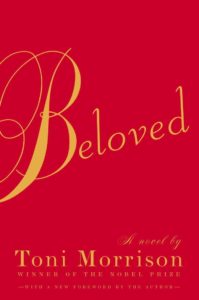
Toni Morrison, Beloved
There is not more I can say about Beloved that has not been said much more concisely and eloquently. When I first came to the book, I discovered something I did not expect coming in: that, along with the myriad things that Beloved is and does, it is also a refugee narrative. The novel positions survival as an act of creation, particularly how mothers who witnessed a generation of a horrific trauma acquire the power of protection through love—even if it means committing the ultimate act of rescue: death. It is a treatise wherein literary violence can—and is at times obligated to—match that of history, that nothing is “too much” or “indulgent” if it is true. I saw in Morrison’s characters the thinking and innovation of women in my family.
Although Morrison’s characters inhabit a completely different historical sequence, incomparable to anything else, the novel taught me to see Vietnamese refugees as survivors with agency, like Sethe, who must now furnish a future within incomprehensible aftermaths. It gave me the confidence and determination to see Vietnamese American life as worthy and exceedingly beautiful in the project of literature.
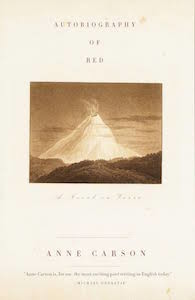
Anne Carson, Autobiography of Red
This hybrid book (a novel in verse) taught me what can happen when a fictive story is contextualized through other texts, where it can collaborate, argue with, and celebrate the original while also gaining its own life. In Carson’s case, it was the recasting and expansion of the classical myth of Geryon. But what’s more, it uses Geryon’s anecdotal life in a larger male-dominated narrative as an epicenter, thereby decentralizing the Greek original into Carson’s contemporary vision of rural queer life, the isolation of art making and the brutal repercussions of favoring interiority in a patriarchal system.
But perhaps what’s most inspiring to me about this book is Carson’s refusal to enact her protagonist’s development via a false and forced inhabitation of heteronormative ideals. Geyron, a quiet, small, artistic mama’s boy, does not become a masculinist hero in order to “solve” his outcast position. Instead, he bravely embodies his otherness, or “monstrosity,” as Carson writes, through emotionally-informed aesthetic vision. It’s a book that insists on the necessity of alterity as agency instead of succumbing to the readily assimilative.
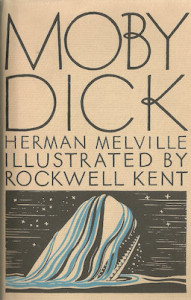
Herman Melville, Moby-Dick
I have always felt that Melville was the writer who enacted Whitman’s decree for American multiplicity in ways far richer and complex than Whitman did himself. A book that simply refuses to compromise, that employs the autobiographical gaze to suggest radical modes of queerness, polytheism as progressive self-knowledge, expansive meditations on whiteness, both in regards to the whale’s purity and to race, Moby-Dick forges the allegory of the hunt as a doomed American quest for self-knowledge. Reading it, I thought, What would happen if a queer Asian American decided, in Melville’s vein, to also not compromise? What would happen if all modes of voices, themes, threads, systems of knowledge and influence were potent in equal measure within the novel’s temporal investigation?
Because I knew I did not want to write a 600-page tome, the epistolary mode allowed me the quick detours and returns, while still retaining the vital urgency and vulnerability of a direct address. In this way, the voice, the letter itself, became the main plot, the digressions in memory, cultural investigations, and vignettes its tributaries. And the whale, ever fleeting, out of reach, and finally impossible, is the mother’s readership of the letter.
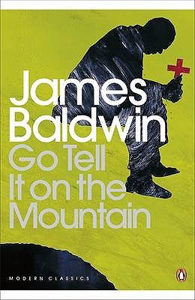
James Baldwin, Go Tell It on the Mountain
The novel that Baldwin claims he “had to write if [he were] ever to write anything else” is a masterclass on how potent and vital an autobiographical text can be for a writer of color. In a literary culture that often casts the debut as arriving out of serendipitous phenomenon, the autobiographical novel, as evidenced by Baldwin, serves as a map of one’s journey towards art. It says, essentially, that a writer of color does not arrive at the literary table, as is often believed, in spite their geographical and cultural roots, but because of them, that those origins, complex and rich with joy and challenges, were foundations within their praxis—not shackles that denied them an imagination.
The Germans would call such a book a künstlerroman—an artist novel. In Baldwin’s hands, Go Tell It becomes more than that, it becomes a map of passage wherein a gay black writer garners self-knowledge through the careful, thorough, and luminous rendering of his elders, which includes their flaws, triumphs, and the near-obliterating effect of American racism on their minds and bodies.
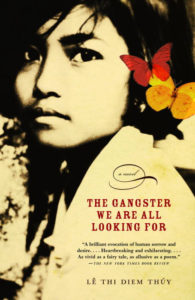
lê thị diễm thúy, The Gangster We Are All Looking For
A truly innovative book that centralizes oscillation and destabilization as a mode of inquiry and storytelling. Moving through multiple points of view, voices and non-linear time, thúy builds a narrative that feels, at times, more like landscape art than writing—all to a tremendous embodied effect. This book was so important to my education as a novelist because it shows how easily writers of color can be relegated incomprehensible if they choose to enlist unconventional, non-canonical models to work from.
thúy not only breaks the rules of traditional Western narrative; she insists that such rules can be consciously rejected because their rubrics were made without considering the bodies her book holds—even at this risk of rendering it, in the eyes of critics trained to recognize and celebrate hegemonic styles, as nonsensical or wrong. The result is a bold and empowering refusal of conformity in search of other ways of speaking and being.
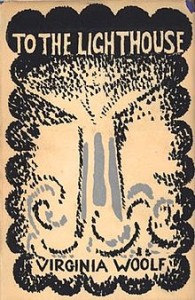
Virginia Woolf, To the Lighthouse
This book still feels anachronistically bold in its total recalibration of conventional plot-making as a means of privileging characters, people and ideas over “story,” all of it a treatise for a woman’s interior life as a central motif for fiction. It’s subtly subversive but also starkly innovative in action—or inaction (the entire narrative can be summed up—with a touch of, but not much, hyperbole—as five people crossing a lawn while a woman tries to finish her painting). What’s so illuminating to me is Woolf’s insistence on the extended metaphor (near Homeric at times) as a means of destabilizing the temporal function of plot. What is real when the metaphor becomes just as felt, if not more so, than the narrated life, when it becomes a portal?
And Woolf did this at a time where overly metaphorical writing, a style that once represented the pinnacle of masculine achievement in the 19th century (James, Melville, Dickens, Whitman), was feminized via epithets like purple, florid, flowery, and unrestrained so to be rendered defunct or passé. In other words, a set of tools can be considered useless only once it has been retroactively prescribed to women. Using that “florid” style in a novel that negotiates a woman’s inner life within the restrictions of patriarchy while also laying bare the arbitrary gendering of style, was and is incredibly radical to me.
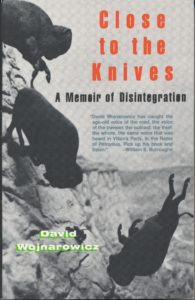
David Wojnarowicz, Close to the Knives: A Memoir of Disintegration
If a personal queer bible could be such a thing, this would be mine. The potent beauty in this collection of essays is evident in its wide swath of styles and range of diction and modes. Wojnarowicz oscillates between essayistic rages against the Reagan administration to deeply lyrical mediations on queer loneliness, illness, artmaking and the mourning of lovers and friends lost to the AIDS epidemic.
It feels at times as if Wojnarowicz’s sentences are attempts at laying ground within a community disintegrating before his eyes and voice. What remains in this collection that spans nearly his entire life is a testament to queer innovation and survival—but also the residue of a boy’s coming of age in broken homes in New Jersey to an equally blighted yet life-savingly vibrant New York. This book shines as one of the most vital prehistories of how queer art is possible today and its impact is still felt all around you, even if you’ve never read it. I will forever be indebted, not only to this book but also David’s life and work.
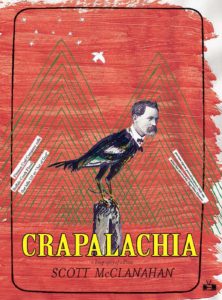
Scott McClanahan, Crapalachia: A Biography of Place
Scott McClanahan is one of those rare writers who achieves Kafka’s credo that a book should be the axe that shatters the icy soul of our interior. Crapalachia, with its tongue-in-cheek title, is anything but refuse and detritus. In fact, it’s a broken and half-sung ode to place and people and history, a personal reclamation of falsehoods cast on rural communities in West Virginia. It shows that just because the place you live in has been written about by others ad infinitum, does not mean it was written with you or your folks in mind. This book gave me the courage and power to write about Hartford, a city both haunted and adored by the specters of literary giants like Wallace Steven, Mark Twain, and Harriet Beecher Stowe.
But what’s most indelible about this book is its commitment to wonder and awe. It looks at a region that is deemed blighted beyond repair by outsiders and insists that the sublime, under the writer’s honest and unflinching gaze, is made as true and palpable within the text as it is for those who live, dance, and die there.
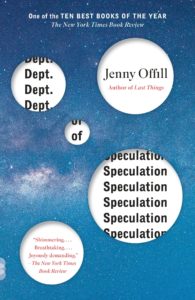
Jenny Offill, Dept of Speculation
A modern testament to the power of the vignette as a narrative strategy. This book collapses Sherwood Anderson’s story cycle novel into Marguerite Duras’s elliptical, episodic style to fashion something entirely its own. What ensues is a refreshed demand for the reader to participate in the novel’s arc, each gap, like stanza breaks in a poem, both asks and allows us to feel the emotional pressures made resonant through associative leaps. This strategy is incredibly difficult to pull off as it demands charged and complicated emotive renderings to carry into white space without thorough bridges and narrative connections.
In other words, it operates using a continuous stream of thematic ricochets that compound as the vignettes increase. It takes a master to wield a book like this without it disintegrating into arbitrary “entries.” As such, reading it is a masterclass in the power and ramification of space and distance. An inexhaustible classic.
__________________________________
Ocean Vuong’s On Earth We’re Briefly Gorgeous is out now from Penguin Press.
Ocean Vuong
Ocean Vuong is the author of the New York Times bestselling poetry collection Time is a Mother (Penguin Press 2022), and the New York Times bestselling novel On Earth We're Briefly Gorgeous (Penguin Press 2019), which has been translated into 37 languages. A recipient of a 2019 MacArthur "Genius" Grant, he is also the author of the critically acclaimed poetry collection Night Sky with Exit Wounds, a New York Times Top 10 Book of 2016, winner of the T.S. Eliot Prize, the Whiting Award, the Thom Gunn Award, and the Forward Prize for Best First Collection. Born in Saigon, Vietnam, he currently lives in Northampton, Massachusetts and serves as a tenured Professor in the Creative Writing MFA Program at NYU.




















